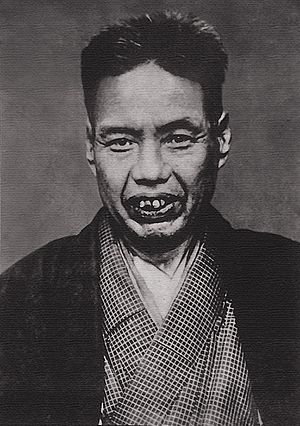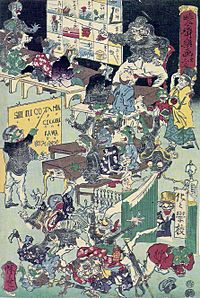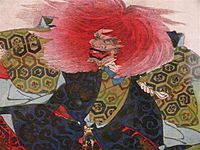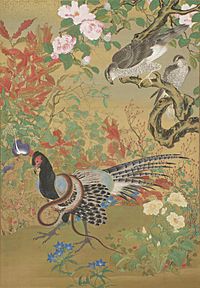Kawanabe Kyōsai facts for kids
Quick facts for kids
Kawanabe Kyōsai
|
|
|---|---|
| 河鍋 暁斎 | |

Kanawabe Kyōsai in 1880s.
|
|
| Born |
Kawanabe Kyosai
18 May 1831 Koga Ishimachi, Shimousa Province, (currently Koga City, Ibaraki Prefecture), Japan
|
| Died | 26 April 1889 (aged 57) Zuirinji Temple, Tokyo, Japan
|
| Resting place | Taitō Ward, Tokyo |
| Nationality | Japanese |
| Education | Utagawa Kuniyoshi, Kanō Eitoku |
| Known for | Painting, drawing, portraits |
| Movement | Ukiyo-e, Japanese Zen, Nihonga |

Kawanabe Kyōsai (河鍋 暁斎, May 18, 1831 – April 26, 1889) was a Japanese artist, in the words of a critic, "an individualist and an independent, perhaps the last virtuoso in traditional Japanese painting".
Biography
Living through the Edo period to the Meiji period, Kyōsai witnessed Japan transform itself from a feudal country into a modern state. Born at Koga, he was the son of a samurai. After working for a short time as a boy with Utagawa Kuniyoshi, he received his artistic training in the Kanō school under Maemura Tōwa (前村洞和, ? – 1841), who gave him the nickname "The Painting Demon", but soon abandoned the formal traditions for the greater freedom of the popular school. During the political ferment which produced and followed the revolution of 1867, Kyōsai attained a reputation as a caricaturist. His very long painting on makimono "The battle of the farts" may be seen as a caricature of this ferment. He was arrested three times and imprisoned by the authorities of the shogunate. Soon after the assumption of effective power by the Emperor, a great congress of painters and men of letters was held at which Kyōsai was present. He again expressed his opinion of the new movement in a caricature, which had a great popular success, but also brought him into the hands of the police this time of the opposite party.
Kyōsai is considered by many to be the greatest successor of Hokusai (of whom, however, he was not a pupil), as well as the first political caricaturist of Japan. His work mirrored his life in its wild and undisciplined nature, and occasionally reflected his love of drink. Although he did not possess Hokusai's dignity, power or reticence, he compensated with a fantastic exuberance, which always lent interest to his technically excellent draughtsmanship.
He created what is considered to be the first manga magazine in 1874: Eshinbun Nipponchi, with Kanagaki Robun. The magazine was heavily influenced by Japan Punch, founded in 1862 by Charles Wirgman, a British cartoonist. Eshinbun Nipponchi had a very simple style of drawings and did not become popular with many people, and ended after just three issues.


In addition to his caricatures, Kyōsai painted a large number of pictures and sketches, often choosing subjects from the folklore of his country, Nô drama, nature and religion, for example The Temptation of Shaka Niorai or The goddess Kwannon on a dragon (on kakejiku frame) A fine collection of these works is preserved in the British Museum; and there are also good examples in the National Art Library at South Kensington and the Guimet Museum at Paris. The Kawanabe Kyōsai Memorial Museum was established in 1977, located at Warabi, Saitama Prefecture, Japan.
A crater on Mercury has been named in his honor.
Information about him: He died because of gastric cancer, Erwin Bälz wrote about it in his diary. If he was his doctor, or if he was present at Kyōsais death is not mentioned. (Source: Erwin Bälz - Das Leben eines deutschen Arztes im erwachenden Japan, Hrsg. Toku Bälz, 1930)
See also
 In Spanish: Kawanabe Kyōsai para niños
In Spanish: Kawanabe Kyōsai para niños

